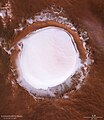Korolev (Martian crater)
 Perspective view of Korolev crater, generated using images and digital terrain data from Mars Express. | |
| Planet | Mars |
|---|---|
| Coordinates | 72°46′N 164°35′E / 72.77°N 164.58°E[1] |
| Quadrangle | Mare Boreum |
| Diameter | 81.4 kilometres (50.6 mi)[1] |
| Eponym | Sergei Korolev (1907-1966), Soviet rocket engineer and designer |
Korolev is an ice-filled impact crater in the Mare Boreum quadrangle of Mars, located at 73° north latitude and 165° east longitude. It is 81.4 kilometres (50.6 mi) in diameter[1] and contains about 2,200 cubic kilometres (530 cu mi) of water ice, comparable in volume to Great Bear Lake in northern Canada.[2] The crater was named after Sergei Korolev (1907–1966), the head Soviet rocket engineer and designer during the Space Race in the 1950s and 1960s.[2]
Korolev crater is located on the Planum Boreum, the northern polar plain which surrounds the north polar ice cap, near the Olympia Undae dune field. The crater rim rises about 2 kilometres (1.2 mi) above the surrounding plains. The crater floor lies about 2 kilometres (1.2 mi) below the rim, and is covered by a 1.8 kilometres (1.1 mi) deep central mound of permanent water ice, up to 60 kilometres (37 mi) in diameter.[2]
Ice formation
The ice is permanently stable because the crater acts as a natural cold trap. The thin Martian air above the crater ice is colder than air surrounding the crater; the colder local atmosphere is also heavier so it sinks to form a protective layer, insulating the ice, shielding it from melting and evaporation.[2][3] Recent research indicates that the ice deposit formed in place within the crater and was not previously part of a once-larger polar ice sheet.[4] The ice in the crater is part of the vast water resources at Mars poles.[3]
-
Natural color view of Korolev crater from Mars Express
-
Color-coded topographic view of Korolev crater based on a digital terrain model from Mars Express data
-
Map of Mare Boreum quadrangle with major features and craters labeled
-
High-resolution image mosaic of Mare Boreum quadrangle from the Viking Orbiter
-
High-resolution topographic map of Mare Boreum quadrangle with features and craters labeled, from Mars Orbiter Laser Altimeter (MOLA) data
See also
- 1855 Korolev, minor planet
- Korolev (lunar crater)
References
- ^ a b c "Gazetteer of Planetary Nomenclature | Korolev". usgs.gov. International Astronomical Union. Retrieved 4 March 2015.
- ^ a b c d "A winter wonderland in red and white – Korolev Crater on Mars". German Aerospace Center (DLR). Retrieved 20 December 2018.
- ^ a b "Mars Express beams back images of ice-filled Korolev crater". The Guardian. Retrieved December 21, 2018.
- ^ Brothers, T. Charles; Holt, John W. (2016). "Three‐dimensional structure and origin of a 1.8 km thick ice dome within Korolev Crater, Mars". Geophysical Research Letters. 43 (4): 1443–1449. Bibcode:2016GeoRL..43.1443B. doi:10.1002/2015GL066440.
External links
- Video (2:56) – Korolev Crater FlyOver on YouTube (Animated; ESA; June 30, 2020)





